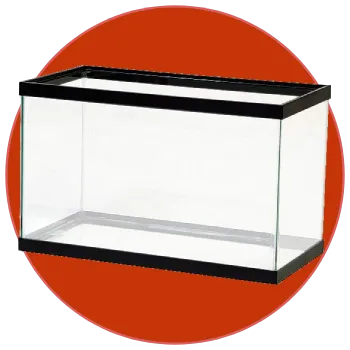
Chapter 3 - Setting up & Maintenance
How to step up and maintain a goldfish tank
Congratulations on reaching the 3rd and final part of our epic Goldfish Care Guide.
Without a long introduction, here’s what you’ll learn today:
- Establish your initial tank setup
- Successfully conduct regular maintenance
- Effectively test and adjust water parameters as needed.
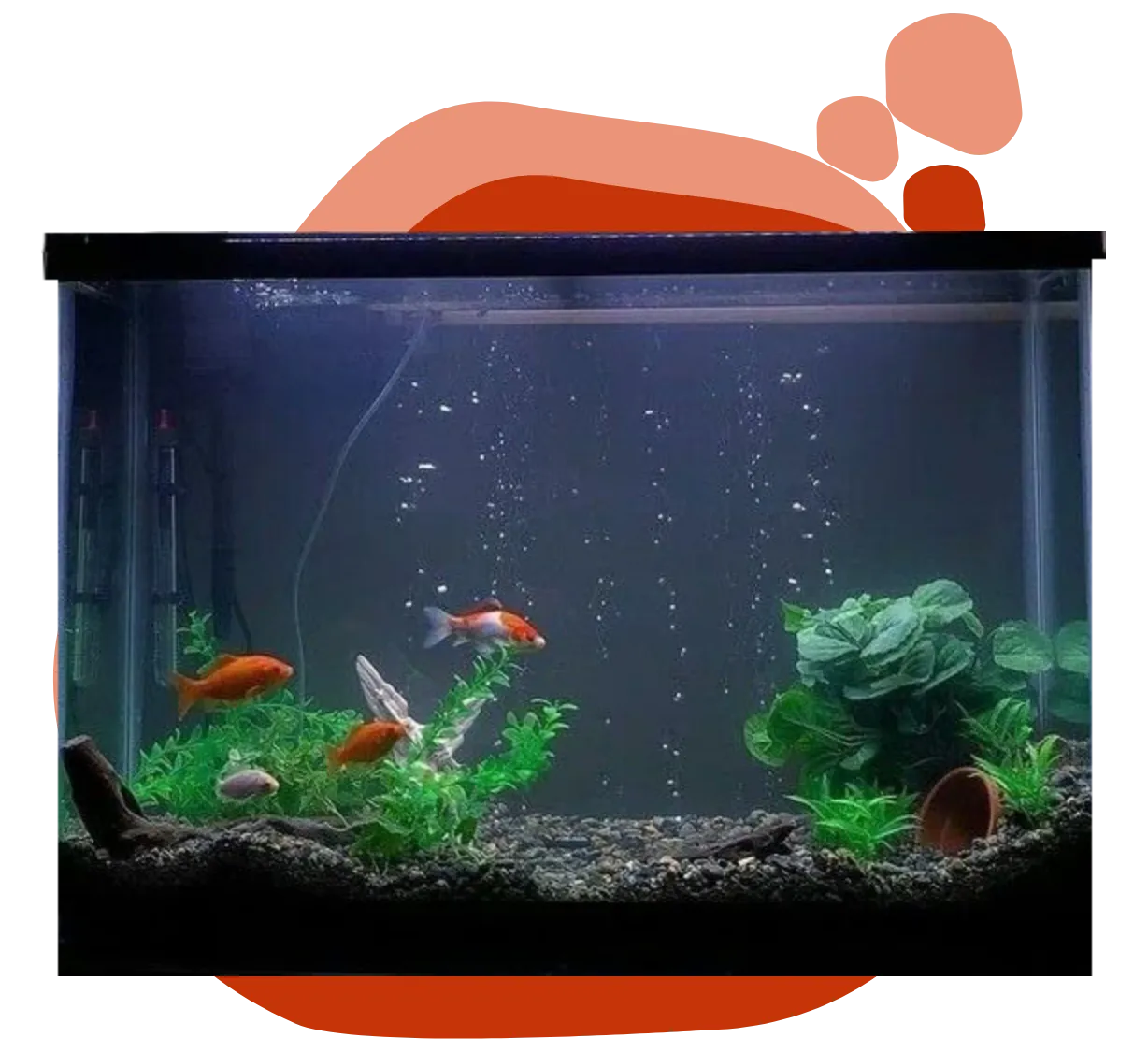
Setting Up Your First Tank
A step-by-step breakdown, explained like you're 5
Setting up your first tank
Run Equipment
Fully assemble and run your equipment
Wait 5 Days
Let it run for 5 days
Water Change
Test the water and change 50% percent of the water
Repeat
Repeat the process 4 more times until water is stable
Step 1: Assemble & Turn On Your Tank
- Set up your tank by assembling it.
- Place the substrate and decorations in the tank.
- Install the filter and heater, then fill the tank with water.
- Add water conditioner according to the label.
- If you’re using real plants- go ahead and plant them.
- Then, turn on the heater and filter.
- Sprinkle a little bit of fish food into the tank. That will kick the ammonia and encourage the filter to start working faster.
Step 2: Let It Run
- Let the tank run as usual for 5 days.
- After 5 days, remove 50% of the water and replace it with conditioned tank water.
- Let it run for another 5 days.
Step 3: Test Water & Repeat
- Test your tank water using a testing strip. Your levels will probably be very much out ideal parameters- which is expected.
- Do another 50% water change as before
- Wait another 5 days, and test the water again.
The key to this process is to not jump the gun. Run a minimum of 3 rounds before you even think about adding any fish. By this stage, the water is still very volatile- because the beneficial bacteria haven’t built up yet. Also remember that the bigger your tank is, the longer it’ll take to build the beneficial bacteria.
What you are looking for is 2 passing tests in a row. Once you get those you know the water will be stable for a minimum of 5 days.
Regular Maintenance
The ultimate care routine
Regular Maintenance Overview
Feed your goldfish commercial fish food twice a day. You can supplement that with another daily feeding of treats- usually in the form of live food like brine shrimp or vegetables like cucumbers or zucchini.
Once a week you’ll want to change about 25% of the water, vacuum the substrate, and scrape algae.
Once a month you’ll have to take your filter apart and rinse it in tank water to remove debris so it maintains it’s flow.
Feeding your Goldfish
We’ve touched on the topic of feeding your goldfish in an earlier chapter, so we’re just going to quickly recap:
Goldfish need a high-protein diet to thrive. Your best options are:
- Commercial fish food
- Live food (like brine shrimp)
Most fish keepers feed their goldfish commercial fish food twice a day. Then there’s room for a treat- which will be live food, with brine shrimp being the most popular.
Weekly Cleaning
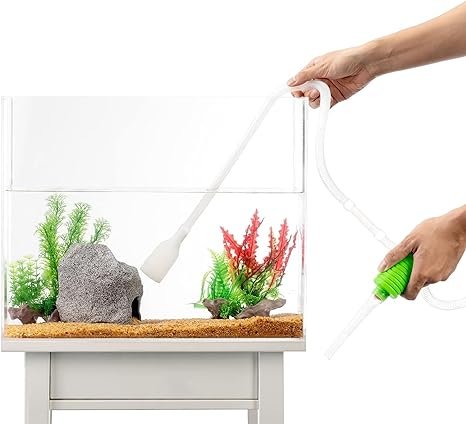
Siphon Substrate
Siphoning removes the leftover fish food and poop on the bottom of the tank
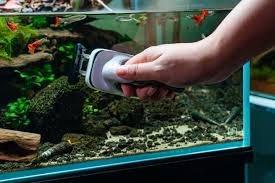
Scrape Algae
Only as you need it, to keep the tank clear and pretty.

Change Water
To balance the parameters and give your goldfish the best living conditions.
One thing you’ll have to do monthly is to clear your filter. Like the others, this a super simple process, but there’s one important thing to remember here:
You have to rinse the filter in tank water. Tap water will kill the beneficial bacteria.
All you’re really doing is removing the debris that is stuck in the filter intake that obstructs the flow. Simply take the filter apart and move it around in a bucket of tank water. Reassemble and re-install.
Testing Your Water
Testing your water is probably the most common task when it comes to fishkeeping- especially as a beginner.
Sometimes, things will go wrong. While the definition of wrong varies, there’s one tell tale sign- your fish are not acting as normal. This might get you scratching your head thinking “How will I know” but the reality is that after watching your tank for a week you’ll be able to spot unusual behavior instinctively.
How to use a testing strip
Using a testing strip is very simple. For the most part, you’ll just follow the instructions on the label.
You typically dip it for a couple of seconds, remove it from the water, shake it, and wait a couple of seconds.
Then you just compare the strip to the guide on the box. If you see parameters that are out of reach- a water change is in order.
It’s that simple.
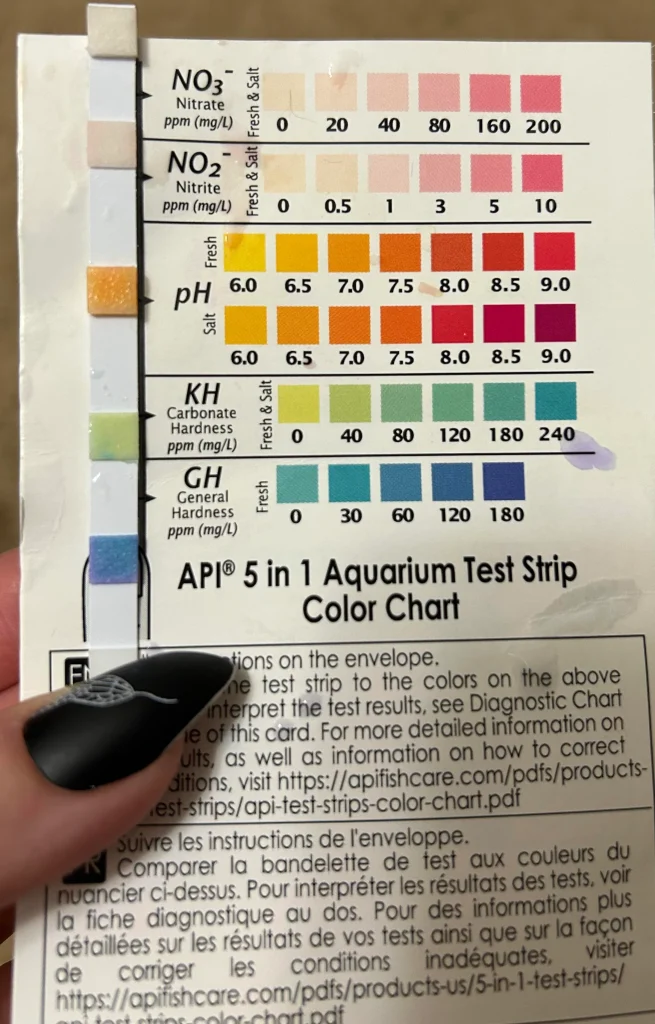
Water Parameters- What do they mean?
There are 5 water parameters, and they all sort of play with each others. they are:
Ammonia
Ideal Range: 0
Nitrite
Ideal Range: 0
Temperature
Ideal Range: 78-82°F (26-28°C)
pH
Ideal Range: 6.5-7.5
Nitrate
Ideal Range: below 20 ppm
Some testing kits (like the one above) will also include measurements for General Hardness (GH) and Carbonate Hardness (KH), but those are directly related to pH. Since goldfish aren’t as sensitive to those parameters as other species, I’ll save you confusion.
Water out of target? Here's how to fix it
Sometimes, and especially in the beginning, your water parameters will be out of the ideal range.
Let me give you a general overview of how frequently you’ll encounter each scenario:
| Parameter | Frequency | What To Do |
|---|---|---|
| Temperature | Rare | Check your thermometer |
| pH | Fairly Rare | Further troubleshooting needed |
| Ammonia | Common | Change the water |
| Nitrite | Common | Change the water |
| Nitrate | Common | Change the water |
Recap
We’ve covered quite a bit here, so let’s recap:
Feed your goldfish twice to three times a day
Clean their tank and change the water once a week.
Clean your filter with tank water once a month.
Test your water every couple of days, or when you see your fish behaving abnormally.
